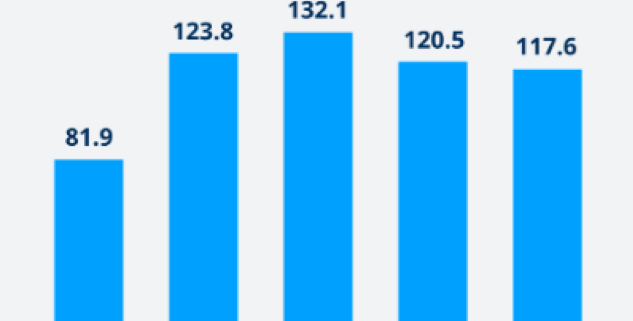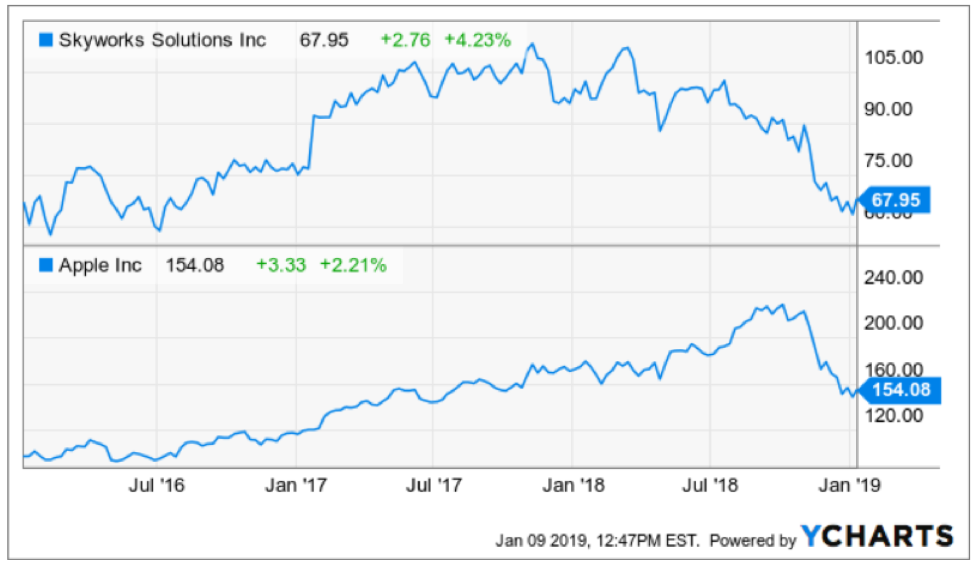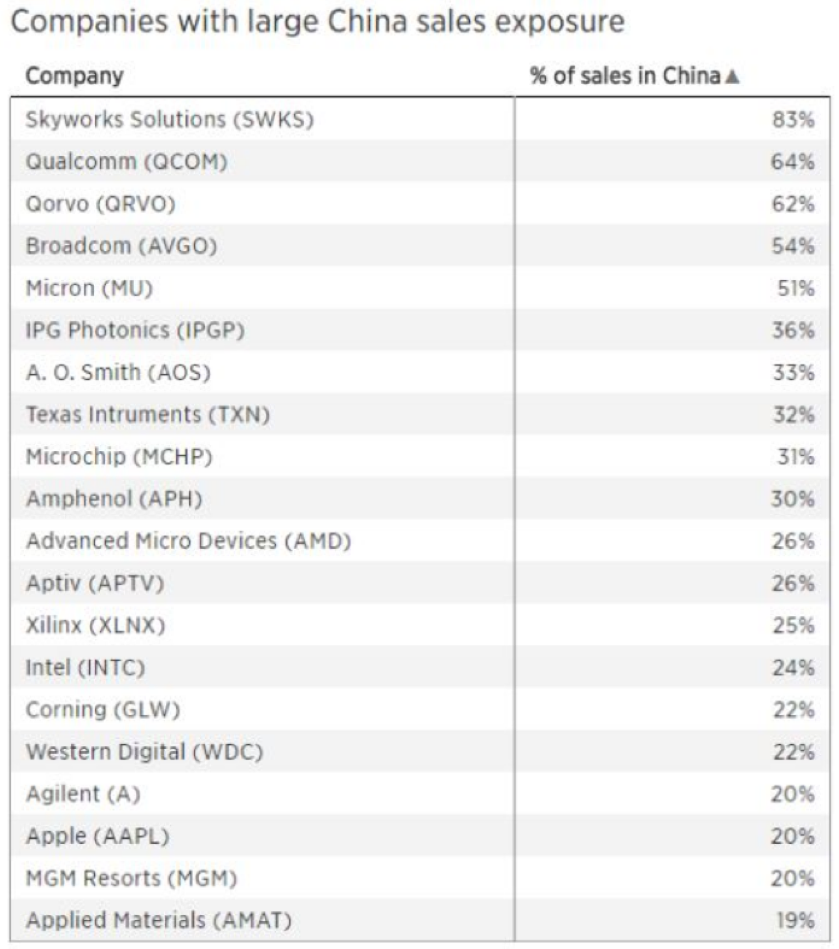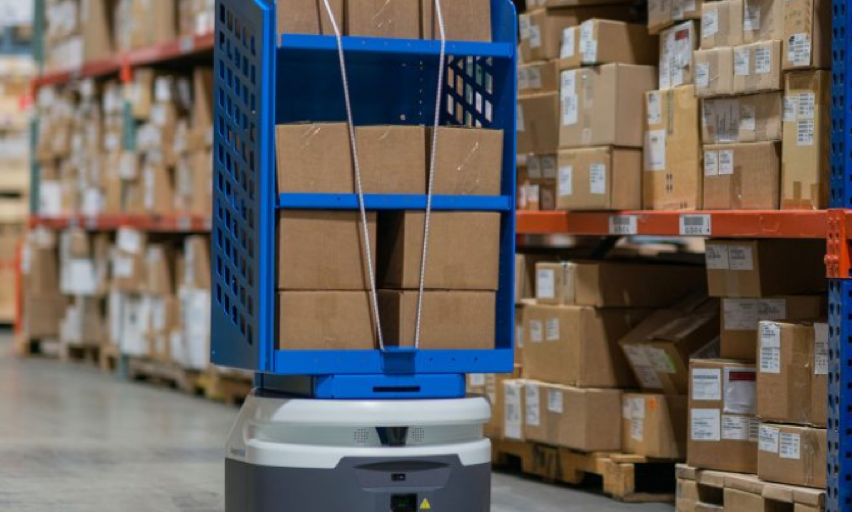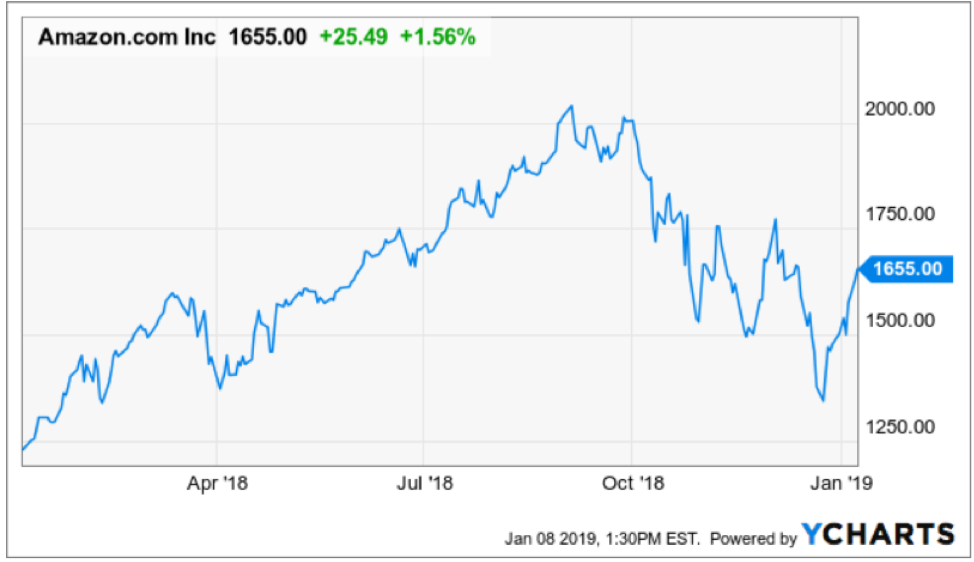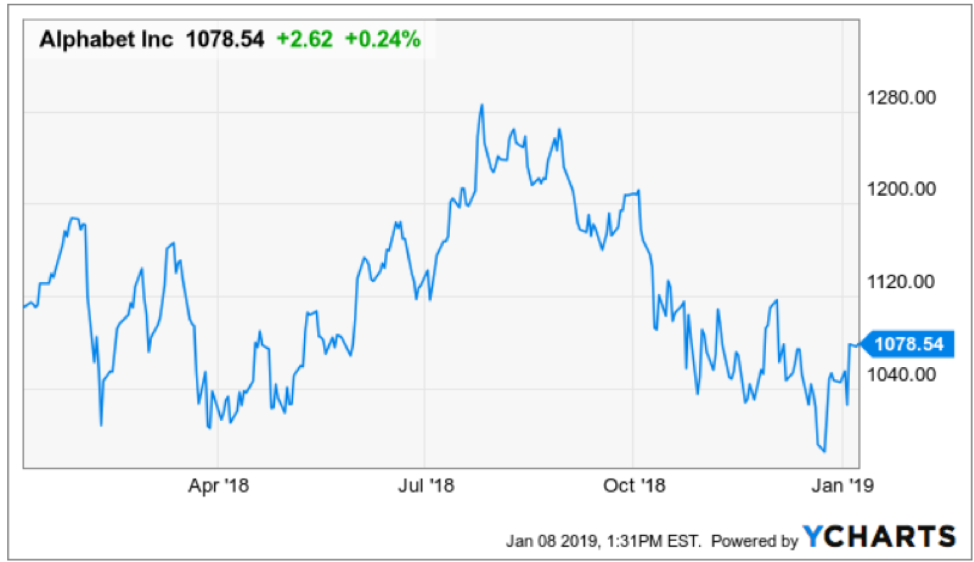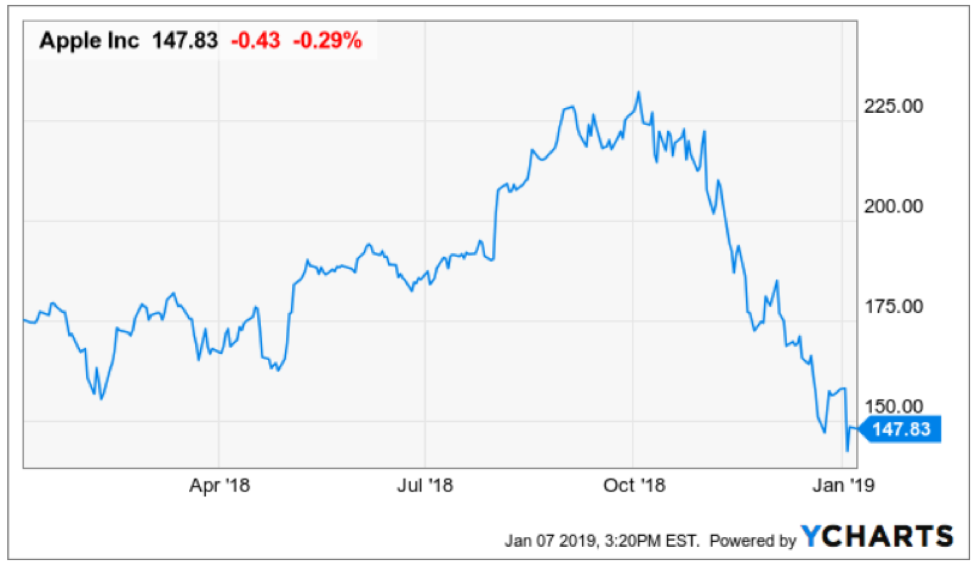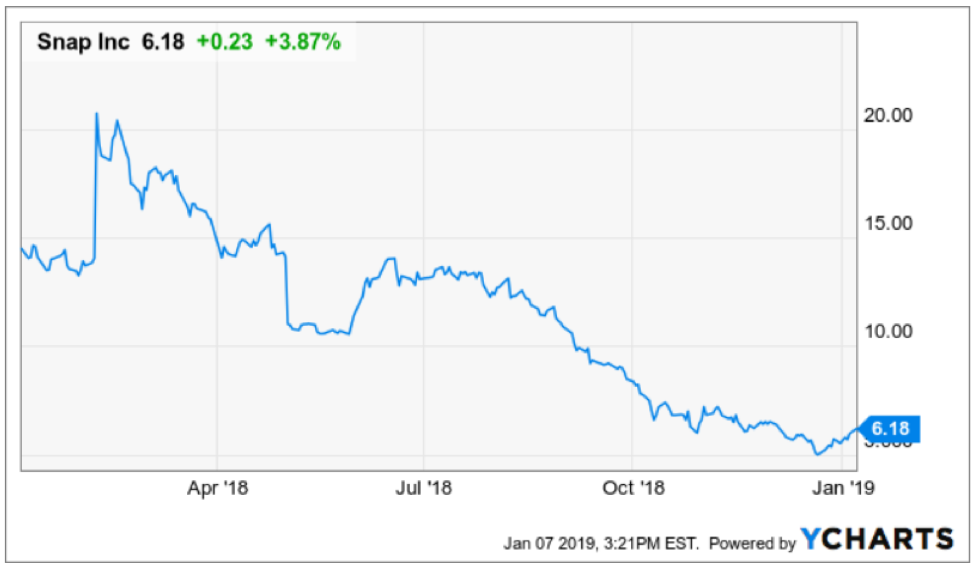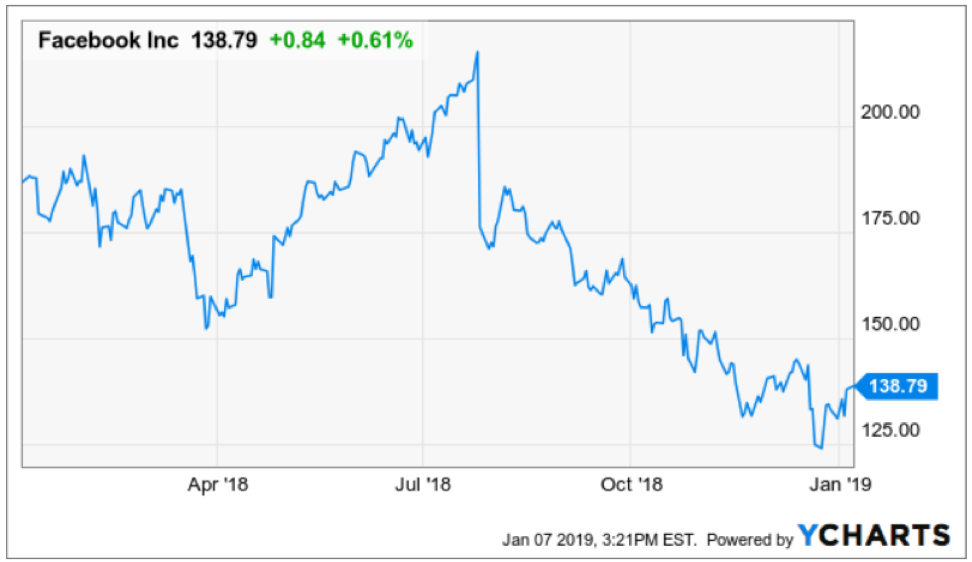“I think the most diverse group will produce the best product; I firmly believe that.” – Said CEO of Apple Tim Cook
Mad Hedge Technology Letter
January 10, 2019
Fiat Lux
Featured Trade:
(HERE’S THE CANARY IN THE COAL MINE FOR APPLE),
(AAPL), (SWKS), (AMZN), (TSLA)
A tech company in the jaws of the trade war dilemma is one to keep tabs on because this company leads Apple’s stock price.
Many industry analysts say that the market cannot recover unless Apple participates.
Paying homage to the sheer size of Apple is one thing, and the gargantuan size means that many other companies are positioned to feed off of Apple revenue model and rely on the iPhone maker for the bulk of their contracts.
Is this a dangerous game to play?
Yes.
But its better than having no business at all.
No stock epitomizes this strategic position better than niche chip stock Skyworks Solutions (SKWS) who extract 83% of total revenue from China.
Apple announced slashing production to its latest iPhone model by 10% in the first quarter due to weak sales.
Apple has also trimmed forecast for total iPhone production from about 48 million to between 40 and 43 million.
The company also failed to meet its latest projected forecast selling a disappointing 46.9 million in the fourth quarter of fiscal 2018, significantly lower than analysts’ expectation of 47.5 million units.
Then when you thought the bottom was in, President of the United States Donald Trump announced an escalation of tariffs from 10% to 25% on Chinese goods that could siphon off 10% of Apple’s revenue from China-produced iPhones.
All this means is that Skyworks Solutions (SWKS) is now the most oversold stock in the tech sector going from $123 about a year ago to about $63.
The avalanche of grumpy news has halted Apple in its track, but Skyworks Solutions is truly ground zero, the metaphorical canary in the coal mine.
The uncertainty that pervades this part of tech does what tech stocks abhor - puts a cap on Skyworks Solutions ceiling and the whole industry which peaked last year.
Containment is the absolute worst description of a tech because it tears apart any remnant of a growth narrative which tech firms need to justify the accelerating investment.
This is evident in how CEO of Tesla (TSLA) Elon Musk ran his business. If he didn’t convince and mesmerize the public with his antics and chutzpah, he might not have cultivated the star power to have pushed through a loss-making enterprise for so long.
Now the loss-making enterprise is history and Musk is finally turning a profit.
Now let’s turn to the chip sector – sling and arrows have been fired with some direct hits.
Samsung reported earnings and scared off investors with a dud.
Management presides over a huge drop in earnings making China and weak sales as the scapegoats.
Samsung’s first profits decline for 2 years could be a sign of things to come.
Chip momentum and earnings are decelerating. There is no getting around that.
Investors will need management to flush out the chip glut and need confirmation that prices have bottomed to really flesh out a legitimate turnaround later this fiscal year.
Samsung curtailed sales estimates by 10% and expect operating profits to sink 28.7% in 2019.
The walking wounded Korean chaebol has also been the recipient of a massive price war against Chinese smartphones, the end result being that consumers are favoring lower-priced Chinese substitutes that match Samsung’s Galaxy 80% of the way.
Remember that when you battle China tech companies – it’s a fight against the Chinese state who subsidizes these behemoths and have access to unlimited loans at favorable interest rates.
Apple has had the same problem, as well as Huawei and Xiaomi, have started producing premium smartphones. Second tier Chinese smartphone makers Oppo and Vivo have also picked up market share at the marginal buyer level.
Semiconductor annual growth in 2018 held up quite well even though a far cry from 2017 when the semiconductor industry expanded 21.6%.
However, this year forecasts to only eke out 6.8% growth and then 2020 will turn negative with growth contracting 1.9%.
These dismal numbers could signal total revenue downshifting below total revenue numbers not seen since 2016.
In short, the chip industry is going backwards and backwards quickly.
I wouldn’t want to bet the ranch on any chip names now because the short-term prospects are grim.
The perfect storm of market saturation, overproduction, facetious geopolitics, weak demand, and unparallel competition is not a good cocktail of drivers towards accelerating earnings growth.
This is, in fact, a recipe for disaster.
And when you look at mobile, the phenomenon has been a true gamechanger and success but let’s face the facts, its already onto its 15th year and petering out.
There is only so much juice you can squeeze from a lemon.
Mobile will last for the time being until something better comes along which is absolutely what the tech markets are screaming for.
Tech companies have monetarily benefitted from this massive migration to mobile and there are still some hot croissants to take home from the bakery but I would estimate that 80% of the low-hanging fruit is off the tree.
That leads me to double down on my recent rant of a lack of innovation.
Google is still making most of its revenue from ad search and going 18 years strong, there will be no plans to stop even in year 30 and beyond.
Apple has been making iPhones for over 12 years.
Oracle is still selling the same dinosaur database software that has barely changed for a generation, except for the prettified front end.
Amazon is the only company that is brimming with innovation and that is the very reason why all companies must react to the Amazon threat because they set the terms of engagement.
The pipeline is fertile to the point its hard to keep track of all the new products coming out of the company.
Bezos has stayed head and shoulders ahead of the competition because the competition has gotten comfortable, content with above average market positioning, and gobbling up the profits.
Once companies start behaving this way, it is the beginning of the end.
Then there is Skyworks Solution.
Can you imagine if Apple ever announced a ground-breaking new product that would see them stop making iPhones?
Skyworks Solution would go out of business.
This elevated existential risk has nudged up the beta on this stock and it trades accordingly.
Apple’s price action lags Skyworks Solution’s, but the chip companies' booms and busts are more exaggerated.
On cue, Skyworks Solutions announced a cut in guidance from $1 billion in revenue to $970 million in 2019.
EPS would drop from an estimated $1.91 to $1.81-$1.84.
Skyworks president and CEO Liam Griffin said they were “impacted by unit weakness across our largest smartphone customers.”
A bottom looks to be forming unless the trade war turns for the worse again.
The silver lining is that Skyworks Solutions is in queue for some hefty 5G contracts for the upcoming network upgrade.
This would be Skyworks Solutions' chance to jump out of the ring of fire and attach themselves to alternative revenue that doesn’t shred their share price in a growing piece of the tech industry.
If Skyworks Solutions manages to successfully pivot to 5G and specifically IoT products, management will finally be able to wipe away the sweat bullets because welding yourself to Apple’s story hasn’t been heavenly as the global smartphone market has calcified.
“The only constant in the technology industry is change.” – Said Founder and CEO of Salesforce Marc Benioff
Mad Hedge Technology Letter
January 9, 2019
Fiat Lux
Featured Trade:
(TOP 8 TECH TRENDS OF 2018),
(GOOGL), (FB), (WMT), (SQ), (AMZN), (ROKU), (KR), (FDX), (UPS), (CRM), (TWLO), (ADBE), (PYPL)
As 2019 christens us with new technological trends, building our portfolio and lives around these themes will give us a leg up in battling the algorithms that have upped the ante in our drive to get ahead.
Now it’s time to chronicle some of these trends that will permeate through the tech universe.
Some are obvious, and some might as well be hidden treasures.
- Smart Areas Will Conspicuously Advance
American consumers will start to notice that locations they frequent and the proximities around them will integrate more smart-tech.
The hoards of data that big tech possesses and the profiles they subsequently create on the American consumer will advance allowing the possibilities of more precise and useful products.
These products won’t just accumulate in a person’s home but in public areas, and business will jump at the chance to improve services if it means more revenue.
Amazon and Google have piled money into the smart home through the voice assistant initiatives and adoption has been breathtaking.
The next generation will provide even more variety to integrate into daily lives.
- Location-based Dispersion Will Ramp Up
The gains in technology have given the consumer broader control over their lives.
The ability to practically manage one’s life from a remote location has remarkably improved leaps and bounds.
The deflation of mobile phone data costs, the advancement of high-speed broadband internet services in developing countries, more cloud-based software accessible from any internet entry point, and the development of affordable professional grade hardware have made life easy for the small business owners.
What a difference a few years make!
This has truly given a headache for traditional companies who have failed to evolve with the times such as television staples who rely on analog advertising revenue.
Millennials are more interested in flicking on their favorite YouTuber channel who broadcast from anywhere and aren’t locally based.
Another example is the quality of cameras and audio equipment that have risen to the point that anybody can become the next Justin Bieber.
Music executives are even using Spotify to target new talent to invest in.
- Overhyped Bitcoin Will Finally Take A Siesta From The Mainstream
Blockchain technology has the makings of transforming the world we live in.
And the currency based on the blockchain technology had a field day in the press and backyard summer barbecues all over the country.
Well, 2019 will finally put this topic on the backburner even though Bitcoin won’t disappear into irrelevancy, the pendulum will swing the other direction and this digital currency will become underhyped.
The rise to $20,000 and the catastrophic selloff down to $4,000 was a bubble popping in front of us.
It made a lot of people rich like the Winklevoss brothers Cameron and Tyler who took the $65 million from Facebook CEO Mark Zuckerberg and spun it into bitcoin before the euphoria mesmerized the American public.
On the way down from $20,000, retail investors were tearing their hair out but that is the type of volatility investors must subscribe to with assets that are far out on the risk curve.
The volatility that FinTech leader Square (SQ) and OTT Box streamer Roku (ROKU) have are nothing compared to the extreme volatility that digital currency investors must endure.
- E-Sports Will Become Even More Popular
Video games classified as a spectator sport will expand up to 40% in 2019.
This phenomenon has already captivated the Asian continent and is coming stateside.
This is a bit out of my realm as standard spectator sports don’t appeal to me much at all, and watching others play video games for fun is something I am even further removed from.
But that’s what the youth like and how they grew up, and this trend shows no signs of stopping.
Industry experts believe that the U.S. is at an inflection point and adoption will accelerate.
Remember that kids don’t play physical sports anymore because of the risk to head trauma, blown ligaments, and the sheer distances involved traveling to and from venues turn participants away.
Franchise rights, advertising, and streaming contracts will energize revenue as a ballooning audience gravitates towards popular leagues, tapping into the fanbase for successful video game series such as Overwatch.
The rise of eSports can be attributed to not only kids not playing physical sports but also younger people watching less television and spending more time online.
Soon, there will be no difference in terms of pay and stature of pro athletes and video gaming athletes.
The amount of money being thrown at the world’s best gamers makes your spine tingle.
- Data Regulation Will Tighten
The era of digital data regulation is upon us and whacked a few companies like Google and Facebook in 2018.
Well, this is just the beginning.
The vacuum that once allowed tech companies to run riot is no more, and the government has big tech in their cross-hairs.
The A word will start to reverberate in social circles around the tech ecosphere – Antitrust.
At some point towards the end of 2019, some of these mammoth technology companies could face the mother of all regulation in dismantling their business model through an antitrust suit.
Companies such as Amazon and Facebook are praying to the heavens that this never comes to fruition, but the rhetoric about it will slowly increase in 2019 because of the mischievous ways these tech companies have behaved.
The unintended consequences in 2018 were too widespread and damaging to ignore anymore.
Antitrust lawsuits will creep closer in 2019 and this has spawned an all-out grab for the best lobbyists tech money can buy.
Tech lobbyists now amount to the most in volume historically and they certainly will be wielded in the best interest of Silicon Valley.
Watch this space.
- Software Favored To Hardware
The demand for smart consumer devices will fall off a cliff because most of the people who can afford a device already are reading my newsletter from it.
The stunting of smart device innovation has made the upgrade cycle duration longer and consumers feel no need to incrementally upgrade when they aren’t getting more bang for their buck.
The late-cycle nature of the economy that is losing momentum because of a trade war and higher interest rates will see companies look to add to efficiencies by upgrading software systems and processes.
This bodes well for companies such as Microsoft (MSFT), Salesforce (CRM), Twilio (TWLO), PayPal (PYPL), and Adobe (ADBE) in 2019.
- Logistics Gets A Boost From Technology
This is where Amazon has gotten so good at efficiently moving goods from point A to point B that it is threatening to blow a hole in the logistic stalwarts of UPS and FedEx.
Robots that help deploy packages in the Amazon warehouses won’t just be an Amazon phenomenon forever.
Smaller businesses will be able to take advantage of more robotics as robotics will benefit from the tailwind of deflation making them affordable to smaller business owners.
Amazon’s ramp-up in logistics was a focal point in their purchase of overpriced grocer Whole Foods.
This was more of a bet on their ability to physically deliver well relative to competition than it was its ability to stock above average quality groceries.
If Whole Foods ever did fail, Amazon would be able to spin the prime real estate into a warehouse located in wealthy areas serving the same wealthy clientele.
Therefore, there is no downside short or long-term by buying Whole Foods. Amazon will be able to fine-tune their logistics strategy which they are piling a ton of innovation into.
Possible new logistical innovations include Amazon attempting to deliver to garages to avoid rampant theft.
This is all happening while Amazon pushes onto FedEx’s (FDX) and UPS’s (UPS) turf by building out their own fleet.
Innovative logistics is forcing other grocers to improve fast giving customers better grocery service and prices.
Kroger (KR) has heavily invested in a new British-based logistics warehouse system and Walmart (WMT) is fast changing into a tech play.
- Tech Volatility Won’t Go Away
Current Chair of the Federal Reserve Jerome Powell unleashed a dragon when he boxed himself into a corner last year and had to announce a rate hike to preserve the integrity of the institution.
Markets whipsawed like a bull at a rodeo and investors lost their pants.
Tech companies who have been leading the economy and trot out robust EPS growth out of a whole swath of industries will experience further volatility as geopolitics and interest rate rhetoric grips the world.
Apple’s revenue warning did not help either and just wait until semiconductors start announcing disastrous earnings.
The short volatility industry crashed last February, and the unwinding of the Fed’s balance sheet mixed with the Chinese avoiding treasury purchases due to the trade war will insert even more volatility into the mix.
Powell attempted to readjust his message by claiming that the Fed “will be patient” and tech shares have had a monstrous rally capped off with Roku exploding over 30% after news of positive subscriber numbers and news of streaming content platform Hulu blowing past the 25 million subscriber mark.
Volatility is good for traders as it offers prime entry points and call spreads can be executed deeper in the money because of the heightened implied volatility.
Mad Hedge Technology Letter
January 8, 2019
Fiat Lux
Featured Trade:
(WHY I SOLD SHORT APPLE),
(AAPL), (FB), (SNAP), (SQ), (AMZN), (BB), (NOK)
Apple (AAPL) needs Jack Dorsey to save them.
That is what the steep sell-off is telling us.
Lately, Apple’s tumultuous short-term weakness is indicative of the broader mare’s nest that large-cap tech is confronting, and the unintended consequences this monstrous profit-making industry causes.
These powerful tech companies have sucked out the marrow of the innovative bones that the American economy represents, applying this know-how to pile up ceaseless profits to the detriment of the incubational start-ups that used to be part and parcel of the DNA of Silicon Valley.
In the last few years, the number of unicorns has been drying up rapidly on a relative basis to decades of the ’90s and the early 2000s – this is not a startling coincidence.
The mighty FANGs were once fledging start-ups themselves but have become entrenched enough to the point they transcend every swath of culture, society, and digital wallet now.
Becoming too big to boss around has its competitive advantages, namely harnessing the hoards of data to destroy any competition that has any iota of chance of uprooting their current business model.
And if these large tech companies can “borrow” the innovation that these smaller firms cultivate, they wield the necessary resources to undercut or just decapitate the burgeoning competition.
The net effect is that innovation has been crushed and the big tech companies are milking their profits for what its worth.
Fair?
Not at all.
But tech has never been a fair game and going to a gun fight with a knife is why militaries incessantly focus on technology to accrue a level of firepower head and shoulders above their peers.
The career of Co-Founder of Jet.com, an e-commerce platform bought by Walmart for $3.3 billion in 2016, perfectly illustrates my point.
Marc Lore was born from the mold of leaders such as Amazon (AMZN) founder Jeff Bezos, leveraging the wonders and functionality of the e-commerce platform to construct a thriving business empire.
Quidsi, an e-commerce company, was founded by Marc Lore on the back of Lore maxing out personal credit cards to rent trucks to head to wholesale stores up and down the East coast to buy diapers, wipes, and formula in large quantities.
Under the umbrella of Quidsi, diapers.com and soap.com were successful e-commerce businesses and a segment that Amazon hadn’t cracked yet.
CEO of Amazon Jeff Bezos identified Lore as a mild threat to his low-end pricing, high-volume business empire.
Yes, this was a market grab, but to avoid a looming and an escalating price war, Amazon bought Quidsi for $500 million and $45 million of debt leaving Lore with millions after repaying earlier investors but effectively neutering Lore and putting him out to pasture.
The best way to ensure there is not another Jeff Bezos is for Jeff Bezos to buy out the upcoming Jeff Bezos before he can get close enough to go for the kill.
While both Bezos and Lore extolled the acquisition with pleasantries, Lore later described it as a glass half empty scenario akin to a mourning.
Getting a golden parachute-like payment for innovation is the best-case scenario for these up and coming stars of tech.
Others aren’t as lucky.
The castle that Bezos built and this type of reaction to stunting competition cannot be quantified and has a net negative effect on the overall level of innovation in the tech sector.
Then there is the worst-case scenario for tech companies such as Snapchat (SNAP). They have been courted numerous times by Facebook (FB) and offered sweetened deals that most people would salivate over.
Each rebuff followed a further Facebook retrenchment onto Snapchat’s territory hoping that they would gradually tap out from this vicious headlock.
In return, Snapchat has had the Turkish carpet pulled out from underneath them and most of their in-house innovation has been borrowed by Facebook’s subsidiary social media platform Instagram.
During this time span, Snapchat’s share price has nosedived and the defiant Snapchat management has lost the momentum and bravado that was emblematic to their business model.
Innovation has also been strangled in Venice, California as declining usership has been partly due to a lack of fresh features and an emphasis on profit creation instead of innovation that led to a botched redesign and sacking of 100 engineers.
Then there is that one's company, two's a crowd and three's a party and Snapchat’s growth model trailed Facebook and Twitter who took advantage of the era of zero regulation to build usership and brand awareness.
Snapchat was late to the feast and has suffered because of it.
The climate and mood for social media have significantly soured in the past six months and have tainted this whole niche sector with one toxic stroke with a brushstroke that has encapsulated any company within two degrees of this sector.
So where do the innovative problems start with Apple?
Right at the top with CEO Tim Cook.
Apple is known for brilliantly rewriting history and not fine-tuning it.
This is why I have preached the emphatic value of erratic but visionary leaders such as Steve Jobs and Elon Musk.
They take big risks and do not apologize for their smoking weed on podcasts and laugh about it.
Investors put up with these shenanigans because these leaders understand the scarcity value of themselves.
They don’t play it safe even if profits are the easiest option.
To save Apple, Apple would need to hire Square and Twitter CEO Jack Dorsey to innovate out of this mess.
The stock would double from here because Dorsey would bring back the innovative juices that once permeated through the corridors in Cupertino through Job’s genius ideas.
Under Cook’s tutelage, Apple has made boatloads of cash, but they were going to do that anyway because of Steve Job’s creations.
However, Cook has presided over China rapidly encroaching on its revenue source and is over-reliant on iPhone revenue.
They had years to develop something new but now China is beating Apple at its own game.
Not only has the smartphone market sullied, but so has the relative innovation that once saw every iPhone iteration vastly different from the prior generation.
The petering out of innovative smartphone features has gifted time to the Chinese to figure out how to snatch iPhone loyalists in China with vastly improved devices but at a way lower price point.
The erosion of Samsung’s market share in China should have been a canary in the coal mine and China is in the midst of replicating this same phenomenon in India too.
And I would argue that this would have never happened if Steve Jobs was still alive.
Jobs would have reinvented the world two times over by now with a product that doesn’t exist yet because that is what Jobs does.
As it is, Cook, a great operation officer, is a liability and probably should still be an operations manager.
Cook blared the sirens in early January with a public interview saying that revenue would drop by $9 billion.
This was the first profit warning in 16 years and won’t be the last if Cook retains his position.
Cook has steered the mystical Apple brand careening into the complex dungeon of communist China and was late to react.
Jobs would act first and others would have to react to his decisions, a staple of innovation.
Sailing Apple’s ship into the eye of the China storm stuck out like a sore thumb once Trump took over.
Adding insult to injury, consumers are opting for cheaper Android-based phones that function the same as iPhones.
The 10% of quality that Apple adds to smartphones isn’t enough to persuade the millions of potential customers to pay $1000 for an iPhone when they can get the same job done with a $300 Android version.
Cook badly miscalculated that Apple would be able to leverage its luxury brand to convince prospective buyers that iPhones would be a daily fixture and can’t-miss product.
Even though it was in 2010, it isn’t now.
The type of price points Apple is offering for new iPhone iterations means that this version of the iPhone should be at least 35% or 40% better than the previous version giving the impetus to customers to trade-up.
Sadly, it’s not and Cook was badly caught out.
Therefore, it is confusing that Apple didn’t apply more of its mountain of capital and luxurious brand status to cobble together a game-changing product.
Cook could have put his stamp on the Apple brand and might not have the chance now.
Cook being an “operations guy” has gone to the well too many times and the narrative and direction of Apple is a big question mark going forward.
This is the exact time needed for some long-term vision.
What does this all mean?
The shares’ horrific sell-off means that it is in line for some breathing room from the relentless downward price action.
However, unless the geopolitical tornados can subside, Apple debuts a Steve Jobs-esque bombshell of a product, or Square (SQ) CEO Jack Dorsey takes over the reins in Cupertino, the share price has limited upside in the short-term.
Apple will not have the momentous and breathtaking gap ups until something is fundamentally changed in the house that Steve Jobs built and that is what the tea leaves are telling us.
This has led me to execute a deep-in-the money put spread to take advantage of this limited upside.
Apple is a great long-term hold, but even Cook is threatening this premise.
As Cook is stewing in his office pondering his uncertain future, he forgets what it was that got Apple to the top of the tech ladder – innovation and lots of it.
The Mad Hedge Technology Letter ranks innovation as the most important input and x-factor a tech company can possess.
Steve Jobs understood that, yet, failed to pass on this hard-learned but important lesson to his protégé.
If Apple stays on the same track, they risk being the next Nokia (NOK) or Blackberry (BB).
WHEN WILL APPLE REVOLUTIONIZE THE WORLD AGAIN?
“You don’t want to negotiate the price of simple things you buy every day.” – Said Founder and CEO of Amazon Jeff Bezos
Mad Hedge Technology Letter
January 7, 2019
Fiat Lux
Featured Trade:
(NOT TOO GOOD TO BE TRUE),
(SCHW), (FB), (SQ), (WMT), (AMZN), (FFIDX), (BOX)
Legal Disclaimer
There is a very high degree of risk involved in trading. Past results are not indicative of future returns. MadHedgeFundTrader.com and all individuals affiliated with this site assume no responsibilities for your trading and investment results. The indicators, strategies, columns, articles and all other features are for educational purposes only and should not be construed as investment advice. Information for futures trading observations are obtained from sources believed to be reliable, but we do not warrant its completeness or accuracy, or warrant any results from the use of the information. Your use of the trading observations is entirely at your own risk and it is your sole responsibility to evaluate the accuracy, completeness and usefulness of the information. You must assess the risk of any trade with your broker and make your own independent decisions regarding any securities mentioned herein. Affiliates of MadHedgeFundTrader.com may have a position or effect transactions in the securities described herein (or options thereon) and/or otherwise employ trading strategies that may be consistent or inconsistent with the provided strategies.




